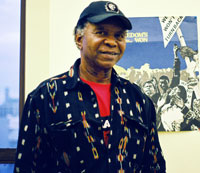From Angola Prison to the New Orleans flood
By
J. Marquardt
San Francisco
Published Nov 5, 2005 12:22 AM
Robert King Wilkerson,
a former prisoner in Louisiana and one of the “Angola 3,” recently
visited San Francisco and spoke with Workers World about his prison experience,
his becoming a political activist and his experience at home in New Orleans in
the aftermath of Hurricane Katrina.
Louisiana State Penitentiary in Angola
was originally a large plantation of white owners of slaves of African origin.
Gradually a town grew up around the plantation and was called Angola.
Some
of the descendants of the Old South’s slave owners remain in the area,
including the Butler and Mayeaux families. It was not a great leap from
plantation to prison, with many of the originally all-white prison guards coming
from the town of Angola.
The Angola 3, all African-American men, were
imprisoned in Angola Prison in the early 1970s and remained in solitary
confinement for three decades. They were each originally imprisoned on unrelated
robbery charges.
At that time many prisoners had become activists in their
communities, like Baton Rouge and New Orleans, before incidents with racist
police and authorities put them together in Angola Prison.
Among these
prisoners were Herman Wallace and Albert Woodfox, who formed a chapter of the
Black Panther Party (BPP) right inside Angola Prison. Around this time Robert
King Wilkerson was also imprisoned.
Wilkerson said, “That’s
when I began to get political consciousness. I was drawn to the revolutionary
program of the BPP. I liked the philosophy of the 10-Point Program, especially
Point #1: We want freedom.
“I also liked the rest of the program,
especially the breakfasts for children and the community healthcare clinics. And
the BPP program included other things important to Black people, like military
service exemption, housing and busing families of prisoners to and from
visits.”
Wilkerson said it was then that he, Herman Wallace and
Albert Woodfox organized political education classes in the prison, where they
learned real history. The prison was segregated then, but their classes were
open to Blacks and whites. This informal integration really bothered the prison
administration, he explained.
That was when the three of them were charged
with the death of a fellow prisoner, which Wilkerson says was a frameup.
Although another inmate confessed to the killing and was convicted of murder,
the three men, known as the “Angola 3,” were additionally accused,
tried and convicted.
Later their inmate accusers retracted their trial
testimony, saying they had been coerced by prison administration officials. But
the Angola 3 remained imprisoned and in solitary confinement for 29
years.
Over those years the three continued to advocate for prisoner
rights, despite each being kept in solitary confinement. Wilkerson said,
“We found a way to communicate.” They waged a hunger strike to
protest the strip and anal body searches all prisoners, already in handcuffs and
shackles, were regularly subjected to.
Although that dehumanizing practice
was eventually curtailed, it has gradually been reintroduced, Wilkerson said,
“under the guise of ‘state security.’”
In October
the New York Times reported a survey that showed Angola Prison has the largest
population of prisoners serving life sentences without the possibility of
parole.
Wilkerson said that traditionally in Louisiana, when a person was
“sentenced to life” it was understood that it was “without
possibility of parole.” Thus, he said, “At least 2,000 or more
remain ‘lifers’ and the only rare exception is through the clemency
process, but it is a difficult, contradictory procedure and rigged against the
prisoner.”
Regarding the aftermath of Hurricane Katrina, Wilkerson
said, “It shouldn’t have gotten to that point. Ever since the 1965
Category 3 Hurricane Bessie, everyone in New Orleans knew the levees needed
repair after years and years of neglect. If the levees had been repaired,
Hurricane Katrina would have meant some electric power losses and little
else.
“After the storm had passed and I felt out of danger, I took
down the coverings he had put at his windows and stepped outside where there
were only some occasional mild wind gusts. Then the levees failed.
“Anyone who tells you it took days for the water to rise is wrong.
It took minutes for the water to rise. In a half hour my house had
seven-and-one-half feet of water in it.”
Both he and his dog were
able to remain dry on the second floor, and eventually friends rescued them with
a boat and he temporarily evacuated to Austin, Texas.
Wilkerson also said
that he has heard people saying that the situation in New Orleans was so bad it
was close to a “race war.” But “it would have been a Civil War
type situation because some whites wanted to help, to struggle alongside the
African Americans, for dignity and safety.”
Wilkerson is now
involved in the survival of New Orleans. And he remains more committed than ever
to win the release of the remaining two members of the Angola 3, who are still
imprisoned, Albert Woodfox and Herman Wallace.
Despite evidence that led
to his own release on Feb. 8, 2001, new evidence of the innocence of the other
two men has not yet led to their exoneration and release. Their story is not
unlike that of Mumia Abu-Jamal.
Wilkerson urges people who want to help
out the people in New Orleans and the Angola 3 to go to the following websites
and get involved. They are: www.commongroundrelief.org and
www.angola3.org.
Articles copyright 1995-2012 Workers World.
Verbatim copying and distribution of this entire article is permitted in any medium without royalty provided this notice is preserved.
Workers World, 55 W. 17 St., NY, NY 10011
Email:
[email protected]
Subscribe
[email protected]
Support independent news
DONATE


